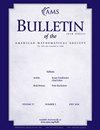Missing digits and good approximations
IF 1.6
3区 数学
Q1 MATHEMATICS
引用次数: 0
Abstract
James Maynard has taken the analytic number theory world by storm in the last decade, proving several important and surprising theorems, resolving questions that had seemed far out of reach. He is perhaps best known for his work on small and large gaps between primes (which were discussed, hot off the press, in our 2015缺少数字和良好的近似值
在过去的十年里,詹姆斯·梅纳德在分析数论领域掀起了一场风暴,他证明了几个重要而令人惊讶的定理,解决了一些似乎遥不可及的问题。他最为人所知的可能是他对质数之间大小间隙的研究(我们在2015年发表的《美国医学科学院公报》文章中对此进行了讨论)。在本文中,我们将讨论梅纳德的另外两个突破:-梅森数的形式为2 n−1 2^n-1,因此以2为基数表示为111…111 111\dots 111,没有数字“0 0”。有无穷多个这样的素数是一个著名的猜想。更一般地说,在梅纳德的研究之前,它是一个悬而未决的问题,即在任何给定的进制中,是否有无限多个质数没有漏掉任何给定的数字。我们将讨论梅纳德在2019年对这个问题的部分解决方案中提出的美丽想法。1926年,Khinchin给出了实数通常可以被无穷多个有理数“很好地近似”的显著条件。然而,钦钦定理把1/2、2/4、3/6看作是不同的有理数,因此不能轻易地加以修改,以应付,比方说,用素数为分母的分数近似。1941年,Duffin和Schaeffer提出了一个恰当但更普遍的类比,只涉及简化分数的近似(这更有用)。我们将讨论Maynard和Dimitris Koukoulopoulos提出的2020年决议。
本文章由计算机程序翻译,如有差异,请以英文原文为准。
求助全文
约1分钟内获得全文
求助全文
来源期刊
CiteScore
2.90
自引率
0.00%
发文量
27
审稿时长
>12 weeks
期刊介绍:
The Bulletin publishes expository articles on contemporary mathematical research, written in a way that gives insight to mathematicians who may not be experts in the particular topic. The Bulletin also publishes reviews of selected books in mathematics and short articles in the Mathematical Perspectives section, both by invitation only.

 求助内容:
求助内容: 应助结果提醒方式:
应助结果提醒方式:


